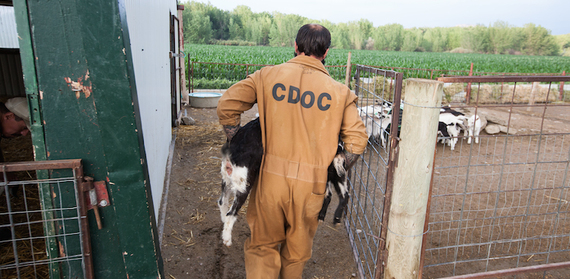Written by Laurel Miller
Although I'm a food and travel writer by vocation, writing about animal-assisted correctional industry programs has become a niche for me, as well as something I'm passionate about, in part because I grew up on a ranch and understand the emotional/therapeutic value of raising and interacting with animals. That said, before I began writing about correctional industries programs, such as Skyline Correctional Center goat dairy (which produces milk for Haystack Mountain Goat Dairy, covered recently in Fortune and Jezebel, and in my own work for culture in 2012's "Doing Time Together"), my general opinion of prisons was that inmates were incarcerated for a reason. Beyond having humanitarian concerns over inmates' living conditions and treatment, I wasn't particularly concerned about how they spent their time. I wasn't even sure I believed in the concept of rehabilitation for repeat offenders (and please note that the programs I'm referring to in this post and yesterday's are for minimum-security inmates, as well as some medium-security offenders who have been transferred for good behavior).
My entire view of the prison system and inmates changed in 2011, however, when I spent two days at the Northern Nevada Correctional Center (NNCC), researching a story for American Cowboy magazine on the NNCC's internationally-acclaimed, self-sustaining Wild Horse Training Program (WHTP). AT WHTP, inmates (who must undergo a rigorous application and approval process) take strays and wild horses, and start them under saddle. The story has been widely praised, and is even featured on the National Correctional Industries Association website.
The four-month-long program enables horses that might otherwise be culled, shipped across the borders for slaughter, or put up for adoption while still feral, to find loving homes via NNCC adoption days. The inmates in turn earn income, produce revenue for the prison and program, and develop critical life and work skills. Most inmates choose to participate for years, often until the end of their terms. To quote from my own story, "The WHTP emphasizes 'least-resistance' training, which is grounded in the principles of the 'revolution in horsemanship' that's gaining popularity worldwide ... It operates on the principles of thinking like the horse (a flight species) and utilizing humane, non-coercive methods to start and train them, be they wild or domesticated. Least-resistance training is rooted in equine behavior, and provides positive reinforcement for both animal and inmate."
Benefits to Inmates
In my American Cowboy story, I interviewed Kathleen O'Meara, Chief Psychologist of the California Department of Corrections and Rehabilitation -- and a horse owner. O'Meara has spent time looking into NNCC's horse program for possible replication in California, and when I asked her to expand on the benefits of such programs, she replied, "Many inmates struggle with low self-worth, poor impulse control, anger management problems, and weak communication skills. Combining a horse/inmate training program with substance abuse treatment [if needed] could tremendously enhance the rehabilitative potential. Horses... survive in the wild through reacting to real or perceived threat, and many inmates identify with [that instinct]."
When I asked O'Meara about the rehabilitative benefits of other animal-related correctional industries programs, she said that similar programs across the country that involve work with animals -- including raising dairy goats and cows -- have the same effect on humans. "Incorporating (animals) into inmate rehabilitation provides them the opportunity become nurturing, patient, and exercise compassion."
The value of these programs is proven by lower recidivism rates. At NNCC, at the time of my research, the rate of recidivism was 15 percent (for the 200 men who have been through the WHTP), compared to 25 percent for NDOC overall. By comparison, said O'Meara, the average national rate hovered around 60 percent. I suspect that a similar pattern results from programs such as the Skyline Correctional Center goat dairy cited by Fortune and Jezebel. Colorado Correctional Industries director Steve Smith didn't have exact CCI statistics for me, but he did state that inmates who go through any of their programs are less likely to end up back in prison; if they work with animals, that likelihood further decreases.
Benefits to Society
For those not swayed by the therapeutic and rehabilitative benefits of such programs, bear this in mind about the Colorado programs: Because the inmates aren't a part of Colorado's general fund, the tax savings to residents at the time of my research in 2012 was over $10 million. All profits generated go back into the programs, as capital for new start-ups and necessary equipment. As with NNCC, the application process for CCI is rigorous, requiring a high school diploma or GED and a good prison record/program compliancy. The waiting list is a long one. And, as reported by both myself and Fortune, Smith's entrepreneurial savvy has resulted in 55 programs, from making exquisite bamboo fishing rods and operating a vineyard and tilapia farm, to training service dogs. Often, these programs are based on the inmate's former occupation, and pay varies, depending upon the program and work experience, but CCI offers incentives (a concept criticized in the Jezebel article) such as significant pay increases.
To recap and add to my argument from yesterday's post, the statistics and feedback make a solid case for the implementation of more national correctional industry programs tailored to inmate's vocational aptitudes, as well as those that, space willing, incorporate animals and agriculture. Not every inmate can or will benefit from these programs, but don't those who have the desire deserve a chance to become productive, skilled, employable members of society?
